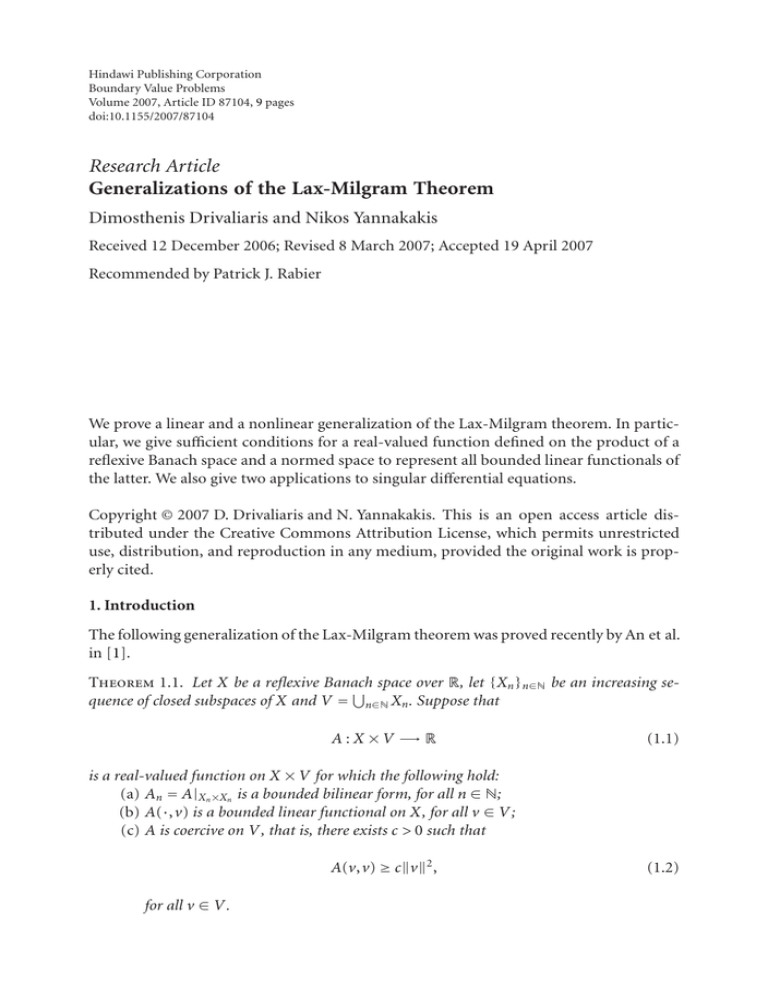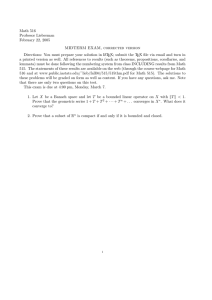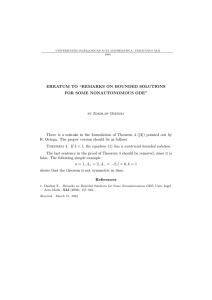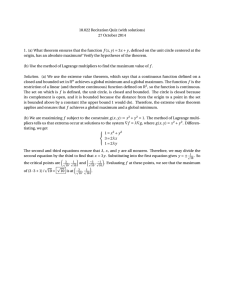Document 10841019
advertisement

Hindawi Publishing Corporation
Boundary Value Problems
Volume 2007, Article ID 87104, 9 pages
doi:10.1155/2007/87104
Research Article
Generalizations of the Lax-Milgram Theorem
Dimosthenis Drivaliaris and Nikos Yannakakis
Received 12 December 2006; Revised 8 March 2007; Accepted 19 April 2007
Recommended by Patrick J. Rabier
We prove a linear and a nonlinear generalization of the Lax-Milgram theorem. In particular, we give sufficient conditions for a real-valued function defined on the product of a
reflexive Banach space and a normed space to represent all bounded linear functionals of
the latter. We also give two applications to singular differential equations.
Copyright © 2007 D. Drivaliaris and N. Yannakakis. This is an open access article distributed under the Creative Commons Attribution License, which permits unrestricted
use, distribution, and reproduction in any medium, provided the original work is properly cited.
1. Introduction
The following generalization of the Lax-Milgram theorem was proved recently by An et al.
in [1].
Theorem 1.1. Let X be a reflexive Banach
space over R, let {Xn }n∈N be an increasing se
quence of closed subspaces of X and V = n∈N Xn . Suppose that
A : X × V −→ R
(1.1)
is a real-valued function on X × V for which the following hold:
(a) An = A|Xn ×Xn is a bounded bilinear form, for all n ∈ N;
(b) A(·,v) is a bounded linear functional on X, for all v ∈ V ;
(c) A is coercive on V , that is, there exists c > 0 such that
A(v,v) ≥ cv2 ,
for all v ∈ V .
(1.2)
2
Boundary Value Problems
Then, for each bounded linear functional v∗ on V , there exists x ∈ X such that
A(x,v) = v∗ ,v ,
(1.3)
for all v ∈ V .
In this paper our aim is to prove a linear extension and a nonlinear extension of
Theorem 1.1. In the linear case, we use a variant of a theorem due to Hayden [2, 3],
and thus manage to substitute the coercivity condition in (c) of the previous theorem
with a more general inf-sup condition. In the nonlinear case, we appropriately modify
the notion of type M operator and use a surjectivity result for monotone, hemicontinuous, coercive operators. We also present two examples to illustrate the applicability of our
results.
All Banach spaces considered are over R. Given a Banach space X, X ∗ will denote its
dual and ·, · will denote their duality product. Moreover, if M is a subset of X, then
M ⊥ will denote its annihilator in X ∗ and if N is a subset of X ∗ , then ⊥ N will denote its
preannihilator in X.
2. The linear case
To prove our main result for the linear case, we need the following lemma which is a
variant of [2, Theorem 12] and [3, Theorem 1].
Lemma 2.1. Let X be a reflexive Banach space, let Y be a Banach space and let
A : X × Y −→ R
(2.1)
be a bounded, bilinear form satisfying the following two conditions:
(a) A is nondegenerate with respect to the second variable, that is, for each y ∈ Y \ {0},
there exists x ∈ X with A(x, y) = 0;
(b) there exists c > 0 such that
sup A(x, y) ≥ cx,
(2.2)
y =1
for all x ∈ X.
Then, for every y ∗ ∈ Y ∗ , there exists a unique x ∈ X with
A(x, y) = y ∗ , y ,
(2.3)
for all y ∈ Y .
Proof. Let T : X → Y ∗ with Tx, y = A(x, y), for all x ∈ X and all y ∈ Y . Obviously ,T
is a bounded linear map. Since, by (b), Tx ≥ cx, for all x ∈ X, T is one to one. To
complete the proof, we need to show that T is onto.
Since A is nondegenerate with respect to the second variable, we have that
⊥
T(X) = y ∈ Y | A(x, y) = 0, ∀x ∈ X = {0}.
(2.4)
D. Drivaliaris and N. Yannakakis 3
Hence
⊥
T(X)
⊥
= Y ∗,
(2.5)
and so by [4, Proposition 2.6.6],
T(X)
w∗
= Y ∗.
(2.6)
Thus to show that T maps X onto Y ∗ , we need to prove that T(X) is w∗ -closed in Y ∗ . To
see that, let {Txλ }λ∈Λ be a net in T(X) and let y ∗ be an element of Y ∗ such that
w∗
Txλ −→ y ∗ .
(2.7)
Without loss of generality, we may assume, using the special case of the Krein-Šmulian
theorem on w∗ -closed linear subspaces (see [4, Corollary 2.7.12]), the proof of which
is originally due to Banach [5, Theorem 5, page 124] for the separable case and due to
Dieudonné [6, Theorem 23] for the general case, that {Txλ }λ∈Λ is bounded. Thus, since
Tx ≥ cx for all x ∈ X, the net {xλ }λ∈Λ is also bounded. Hence, since X is reflexive,
there exist a subnet {xλμ }μ∈M and an element x of X such that {xλμ }μ∈M converges weakly
w∗
to x. Since T is w − w∗ continuous, Txλμ → Tx. Hence Tx = y ∗ , and so T(X) is w∗ closed.
Remark 2.2. An alternative proof of the previous lemma can be obtained using the closed
range theorem.
We are now in a position to prove our main result for the linear case.
Theorem 2.3. Let X be a reflexive Banach space, let Y be a Banach space, let Λ be a directed
set, let {Xλ }λ∈Λ be a family of closed subspaces
of X, let {Yλ }λ∈Λ be an upwards directed
family of closed subspaces of Y , and let V = λ∈Λ Yλ . Suppose that
A : X × V −→ R
(2.8)
is a function for which the following hold:
(a) Aλ = A|Xλ ×Yλ is a bounded bilinear form, for all λ ∈ Λ;
(b) A(·,v) is a bounded linear functional on X, for all v ∈ V ;
(c) Aλ is nondegenerate with respect to the second variable, for all λ ∈ Λ;
(d) there exists c > 0 such that for all λ ∈ Λ,
sup
y ∈Yλ , y =1
Aλ (x, y) ≥ cx,
(2.9)
for all x ∈ Xλ .
Then, for each bounded linear functional v∗ on V , there exists x ∈ X such that
A(x,v) = v∗ ,v ,
for all v ∈ V .
(2.10)
4
Boundary Value Problems
Proof. Let v∗ ∈ V ∗ , and for each λ ∈ Λ, let vλ∗ = v∗ |Yλ . For all λ ∈ Λ, vλ∗ is a bounded
linear functional on Yλ . By hypothesis, for all λ ∈ Λ, Aλ is a bounded bilinear form on
Xλ × Yλ satisfying the two conditions of Lemma 2.1. Since for all λ ∈ Λ, Xλ is a reflexive
Banach space, we get that for each λ ∈ Λ, there exists a unique xλ such that Aλ (xλ , y) =
vλ∗ , y , for all y ∈ Yλ . Since A satisfies condition (d), we get that for all λ ∈ Λ,
c x λ ≤
sup
y ∈Yλ , y =1
Aλ (xλ , y) =
sup
y ∈Yλ , y =1
∗ v , y ≤ v ∗ .
λ
(2.11)
So {xλ }λ∈Λ is a bounded net in X. Since X is reflexive, there exist a subnet {xλμ }μ∈M of
{xλ }λ∈Λ and x in X such that {xλμ }μ∈M converges weakly to x.
We are going to prove that A(x,v) = v∗ ,v, for all v ∈ V . Take v ∈ V . Then there
exists some λ0 ∈ Λ with v ∈ Yλ0 . Since {xλμ }μ∈M is a subnet of {xλ }λ∈Λ , there exists some
μ0 ∈ M with λμ0 ≥ λ0 . Hence, since the family {Yλ }λ∈Λ is upwards directed,
v ∈ Yλμ ,
(2.12)
for all μ ≥ μ0 . Thus, for all μ ≥ μ0 ,
Aλμ xλμ ,v = vλ∗μ ,v .
(2.13)
Therefore
lim A xλμ ,v = v∗ ,v .
(2.14)
μ ∈M
Since A(·,v) is a bounded linear functional on X,
lim A xλμ ,v = A(x,v).
(2.15)
μ ∈M
Hence A(x,v) = v∗ ,v.
The following example illustrates the possible applicability of Theorem 2.3.
Example 2.4. Let a ∈ C 1 (0,1) be a decreasing function with limt→0 a(t) = ∞ and a(t) ≥ 0,
for all t ∈ (0,1). We will establish the existence of a solution for the following Cauchy
problem:
u + a(t)u = f
a.e. on (0,1),
(2.16)
u(0) = 0,
where f ∈ L2 (0,1).
1
Let X = {u ∈ H 1 (0,1) | u(0) = 0} be equipped with the norm u = ( 0 |u |2 dt)1/2 ,
which is equivalent to the original Sobolev norm, and Y = L2 (0,1). Note that X is a reflexive Banach space, being a closed subspace of H 1 (0,1). Let {αn }n∈N be a decreasing
sequence in (0,1) with limn→∞ αn = 0. Define
Xn = u ∈ H 1 αn ,1 | u αn = 0 ,
Yn = L2 αn ,1
(2.17)
D. Drivaliaris and N. Yannakakis 5
of X and Y , resp., by extending their
(we can consider Xn and Yn as closed subspaces
elements by zero outside (αn ,1)). Also let V = ∞
n=1 Yn .
Let A : X × V → R be the bilinear map defined by
A(u,v) =
1
0
u v dt +
1
0
a(t)uv dt.
(2.18)
A is well defined and A(·,v) is a bounded linear functional on X for any v ∈ V .
Let An = A|Xn ×Yn . An be a bounded bilinear form since
An (u,v) ≤ 1 + Mn uX v Y ,
n
n
(2.19)
where Mn is the bound of a on [αn ,1]. It should be noted that A is not bounded on the
whole of X × V .
To show that An is nondegenerate, let v ∈ Yn and assume that An (u,v) = 0 for all u ∈
Xn , that is,
1
u + a(t)u v dt = 0,
αn
∀u ∈ Xn .
(2.20)
It is easy to see that the above implies that
1
αn
wv dt = 0,
(2.21)
for any continuous function w, and therefore v = 0.
We next show that
sup
v =1, v ∈Yn
An (u,v) ≥ uX .
n
(2.22)
Define Tn : Xn → Yn∗ by Tn u,v = An (u,v). Tn is a well-defined bounded linear operator
and Tn u = u + a(t)u. Hence
Tn u2 =
=
=
1
αn
1
αn
1
αn
u + a(t)u2 dt
|u |2 dt +
2
|u | dt +
1
αn
1
αn
a2 (t)|u|2 dt +
1
αn
a(t)(u2 ) dt
(2.23)
a2 (t) − a (t) |u|2 dt + a(1)u2 (1) ≥ u2Xn ,
since u(αn ) = 0, a is decreasing and a(t) ≥ 0 for all t ∈ (0,1).
All the hypotheses of Theorem 2.3 are hence satisfied and so if F ∈ V ∗ is defined by
1
F(v) = 0 f v dt, then there exists u ∈ X such that
A(u,v) = F(v),
Thus u satisfies (2.16).
∀v ∈ V.
(2.24)
6
Boundary Value Problems
3. The nonlinear case
We start by recalling some well-known definitions.
Definition 3.1. Let T : X → X ∗ be an operator. Then T is said to be
(i) monotone if Tx − T y,x − y ≥ 0, for all x, y ∈ X;
w
(ii) hemicontinuous if for all x, y ∈ X, T(x + t y) → Tx as t → 0+ ;
(iii) coercive if
Tx,x
= ∞.
x→∞ x lim
(3.1)
We also need the following generalization of the notion of type M operator (for the
classical definition, see [7] or [8]).
Definition 3.2. Let X be a Banach space, let V be a linear subspace of X, and let
A : X × V −→ R
(3.2)
be a function. Then A is said to be of type M with respect to V if for any net {vλ }λ∈Λ in
V ,x ∈ X and v∗ ∈ V ∗ ;
w
(a) vλ → x;
(b) A(vλ ,v) → v∗ ,v, for all v ∈ V ;
v∗ ,x, where v∗ is the extension of v∗ on the closure of V ,
(c) A(vλ ,vλ ) → imply that A(x,v) = v∗ ,v, for all v ∈ V .
Our result is the following.
Theorem 3.3. Let X be a reflexive Banach space, let Λ be a directed
set, let {Xλ }λ∈Λ be an
upwards directed family of closed subspaces of X, and let V = λ∈Λ Xλ . Suppose that
A : X × V −→ R
(3.3)
is a function for which the following hold:
(a) A is of type M with respect to V ;
(b) limx→∞ A(x,x)/ x = ∞;
(c) Aλ (x, ·) ∈ Xλ∗ , for all λ ∈ Λ and all x ∈ Xλ , where Aλ is the restriction of A on
Xλ × Xλ ;
(d) the operator Tλ : Xλ → Xλ∗ , defined by Tλ x, y = Aλ (x, y) for all x, y ∈ Xλ , is monotone and hemicontinuous for all λ ∈ Λ.
Then for each v∗ ∈ V ∗ , there exists x ∈ X such that
A(x,v) = v∗ ,v ,
(3.4)
for all v ∈ V .
Proof. As in the proof of Theorem 2.3, for each λ ∈ Λ, let vλ∗ = v∗ |Xλ . By the BrowderMinty theorem (see [8, Theorem 26.A]), a monotone, coercive, and hemicontinuous operator, from a real reflexive Banach space into its dual, is onto. Thus, by (b) and (d), for
D. Drivaliaris and N. Yannakakis 7
each λ ∈ Λ, the operator Tλ is onto and so there exists xλ ∈ Xλ such that
Aλ xλ , y = vλ∗ , y ,
(3.5)
for all y ∈ Xλ . In particular Aλ (xλ ,xλ ) = vλ∗ ,xλ , and hence by (b), we get that the net
{xλ }λ∈Λ is bounded. Continuing as in the proof of Theorem 2.3 and applying the fact
that A is of type M with respect to V , we get the required result.
Remark 3.4. It should be noted that since a crucial point in the above proof is the existence
and boundedness of the net {xλ }λ∈Λ , variants of the previous theorem could be obtained
using in (b) and (d) alternative conditions corresponding to other surjectivity results.
We now apply Theorem 3.3 to a singular Dirichlet problem.
Example 3.5. Let Ω be a bounded domain in RN . We consider the Dirichlet problem
−
N
∂
i=1
∂xi
a(x)
∂u
+ f (x,u) = 0 a.e. on Ω,
∂xi
(3.6)
u = 0 on ∂Ω,
where a ∈ L∞
loc (Ω) and there exists c1 > 0 such that a(x) ≥ c1 a.e. on Ω, and f : Ω × R →
R is a monotone increasing (with respect to its second variable for each fixed x ∈ Ω)
Carathéodory function, for which there exist h ∈ L2 (Ω) and c2 > 0 such that
f (x,u) ≤ h(x) + c2 |u|,
∀x ∈ Ω, u ∈ R.
(3.7)
We will show that if the above hypotheses on a and f hold, then problem (3.6) has a weak
solution, that is, that there exists a function u ∈ H01 (Ω) with
Ω
a(x)∇u∇v dx +
Ω
f (x,u)vdx = 0,
∀v ∈ C0∞ (Ω).
(3.8)
To this end, let X = H01 (Ω), let {Ωn }n∈N be an increasing sequence of open subsets of
Ω such that Ωn ⊆ Ωn+1 and
∞
Ωn = Ω
(3.9)
n =1
and Xn = H01 (Ωn ), for each n ∈ N. Observe that we can consider each Xn as a closed
subspace of X by extending its elements by zero outside Ωn and let
V=
∞
Xn .
(3.10)
n =1
Finally, let
A : X × V −→ R
(3.11)
8
Boundary Value Problems
be the function defined by
A(u,v) =
Ω
a(x)∇u∇v dx +
Ω
f (x,u)v dx.
(3.12)
By a(x) ≥ c1 a.e. on Ω, the monotonicity of f , and the growth condition (3.7), we have
A(u,u) =
=
Ω
Ω
a(x)|∇u|2 dx +
Ω
a(x)|∇u|2 dx +
f (x,u)udx
Ω
f (x,u) − f (x,0) udx +
Ω
f (x,0)udx
(3.13)
≥ c1 ∇u2L2 (Ω) − hL2 (Ω) uH01 (Ω) .
Since by the Poincaré inequality ∇uL2 (Ω) is equivalent to the norm of X, it follows that
A is coercive.
∞
Let An = A|Xn ×Xn . Then, since a ∈ L∞
loc (Ω), it follows that a ∈ L (Ωn ), for all n ∈ N.
Combining this with (3.7), we have that
An (u,v) ≤ c(u,n)v X ,
n
(3.14)
where c(u,n) is a positive constant depending on n and u. So the operator
Tn : Xn −→ Xn∗ ,
(3.15)
with Tn u,vXn = An (u,v), is well defined for all n ∈ N. Let
T1,n ,T2,n : Xn −→ Xn∗
(3.16)
be the operators defined by
T1,n u,v
Xn
=
Ωn
a(x)∇u∇v dx,
T2,n u,v
Xn
=
Ωn
f (x,u)v dx.
(3.17)
Then T1,n is a monotone bounded linear operator. Using the monotonicity of f , it is easy
to see that T2,n is monotone. Finally, recalling that the Nemytskii operator corresponding
to f is continuous (see, e.g., [8, Proposition 26.7]) and that the embedding of Xn into
L2 (Ωn ) is compact, we have that T2,n is hemicontinuous. Thus Tn = T1,n + T2,n is monotone and hemicontinuous for all n ∈ N.
w
To finish the proof, let un → u in X. Then since for all v ∈ V ,
u −→
Ω
a(x)∇u∇v dx
(3.18)
is a bounded linear functional and, by the continuity of the Nemytskii operator and the
compactness of the embedding of X into L2 (Ω),
Ω
f x,un v dx −→
Ω
f (x,u)v dx,
(3.19)
D. Drivaliaris and N. Yannakakis 9
for all v ∈ V , we get that
A un ,v −→ A(u,v),
∀v ∈ V.
(3.20)
Thus A is of type M with respect to V . Applying now Theorem 3.3 we get that there exists
u ∈ X such that A(u,v) = 0 for all v ∈ V . Observing that C0∞ (Ω) is contained in V , we get
that u is the required weak solution of (3.6).
Acknowledgments
The authors would like to thank Professor A. Katavolos for pointing out an error in an
earlier version of this paper and the two referees for comments and suggestions which
improved both the content and the presentation of this paper.
References
[1] L. H. An, P. X. Du, D. M. Duc, and P. V. Tuoc, “Lagrange multipliers for functions derivable along
directions in a linear subspace,” Proceedings of the American Mathematical Society, vol. 133, no. 2,
pp. 595–604, 2005.
[2] T. L. Hayden, “The extension of bilinear functionals,” Pacific Journal of Mathematics, vol. 22, pp.
99–108, 1967.
[3] T. L. Hayden, “Representation theorems in reflexive Banach spaces,” Mathematische Zeitschrift,
vol. 104, no. 5, pp. 405–406, 1968.
[4] R. E. Megginson, An Introduction to Banach Space Theory, vol. 183 of Graduate Texts in Mathematics, Springer, New York, NY, USA, 1998.
[5] S. Banach, Théorie des Opérations Linéaires, Monografje Matematyczne, Warsaw, Poland, 1932.
[6] J. Dieudonné, “La dualité dans les espaces vectoriels topologiques,” Annales Scientifiques de
l’École Normale Supérieure. Troisième Série, vol. 59, pp. 107–139, 1942.
[7] H. Brezis, “Équations et inéquations non linéaires dans les espaces vectoriels en dualité,” Annales
de l’Institut Fourier. Université de Grenoble, vol. 18, no. 1, pp. 115–175, 1968.
[8] E. Zeidler, Nonlinear Functional Analysis and Its Applications. II/B, Springer, New York, NY, USA,
1990.
Dimosthenis Drivaliaris: Department of Financial and Management Engineering,
University of the Aegean, 31 Fostini Street, 82100 Chios, Greece
Email address: d.drivaliaris@fme.aegean.gr
Nikos Yannakakis: Department of Mathematics, School of Applied Mathematics and Natural
Sciences, National Technical University of Athens, Iroon Polytexneiou 9, 15780 Zografou, Greece
Email address: nyian@math.ntua.gr







